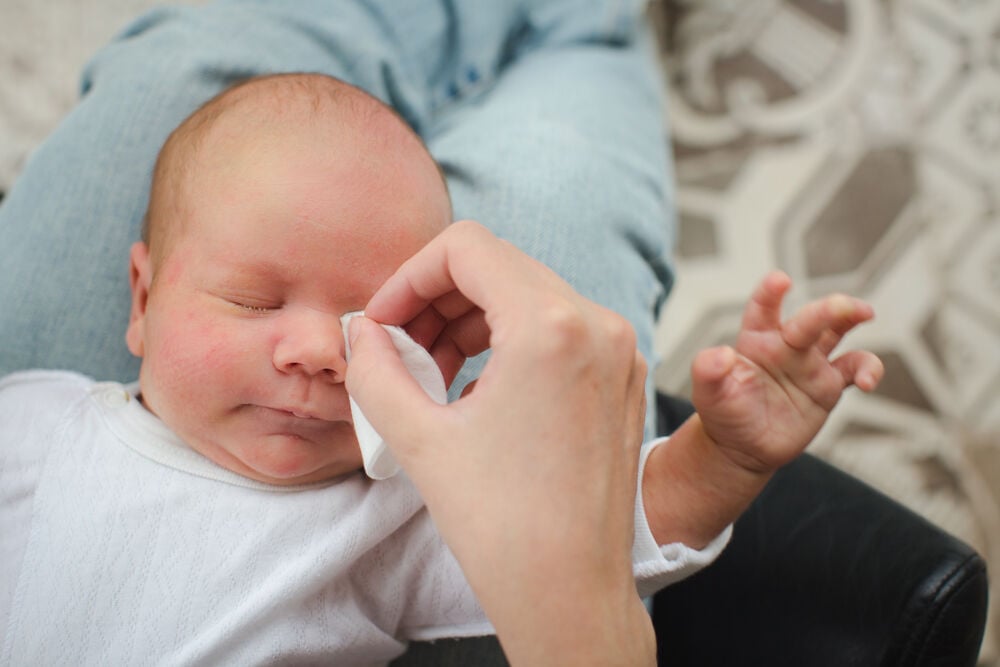-
Tracking cycle
-
Getting pregnant
-
Pregnancy
-
Help Center
-
Flo for Partners
-
Anonymous Mode
-
Flo app reviews
-
Flo Premium New
-
Secret Chats New
-
Symptom Checker New
-
Your cycle
-
Health 360°
-
Getting pregnant
-
Pregnancy
-
Being a mom
-
LGBTQ+
-
Quizzes
-
Ovulation calculator
-
hCG calculator
-
Pregnancy test calculator
-
Menstrual cycle calculator
-
Period calculator
-
Implantation calculator
-
Pregnancy weeks to months calculator
-
Pregnancy due date calculator
-
IVF and FET due date calculator
-
Due date calculator by ultrasound
-
Medical Affairs
-
Science & Research
-
Pass It On Project New
-
Privacy Portal
-
Press Center
-
Flo Accuracy
-
Careers
-
Contact Us
Baby Eye Ointment: All You Need to Know


Every piece of content at Flo Health adheres to the highest editorial standards for language, style, and medical accuracy. To learn what we do to deliver the best health and lifestyle insights to you, check out our content review principles.
Does your baby need eye ointment?
Eye ointments can be used to treat or prevent different eye infections. The most common use of antibiotic eye ointments is to prevent ophthalmia neonatorum, which is an eye infection that can affect newborns. Ophthalmia neonatorum affects babies who are born to mothers who are infected with chlamydia. As the baby passes through the birth canal, their eyes can become infected with Neisseria gonorrhoeae, which is the bacteria that causes gonorrhea.
If a woman doesn't get screened for sexually transmitted infections (STIs), she might not know that she has contracted gonorrhea. Babies with this illness might not show any symptoms at birth. Symptoms can develop up to 5 days after delivery. Their eyes will become red, puffy, and pussy. Ophthalmia neonatorum requires intravenous antibiotics and a longer hospital stay, and it can result in permanent eye damage and blindness.
To prevent this disease, an ophthalmic ointment is applied to every newborn's eyes. This ointment contains the antibiotic erythromycin. A doctor or nurse will apply a thin strip of ointment under each of your baby's lower eyelids. The ointment will cause their vision to be blurry for a few minutes, but it doesn't hurt or burn. Many physician and health organizations recommend applying eye ointment to all newborns.
Antibiotic eye ointment: what's it for?
Gonorrhea isn't the only bacteria that can cause eye infections in babies and children. Other causes of neonatal ophthalmia include chlamydia, bacteria such as staphylococcus and streptococcus, and viral infections like herpes. While most other microorganisms only cause a mild infection, neonatal conjunctivitis caused by gonorrhea can have serious consequences. Ophthalmia neonatorum affects 30 to 50 percent of children born to mothers with gonorrhea if preventative measures aren't taken during birth.
It's also important to keep in mind that newborns aren't the only ones who can get an eye infection. Toddlers and older children can also suffer from eye infections. Conjunctivitis in children is usually caused by viruses or allergies; however, they can also be caused by bacteria. If your child has swollen eyelids, red eyes, and yellowish discharge, they have probably contracted bacterial conjunctivitis. Their pediatrician can prescribe an antibiotic eye ointment to treat it.
How to apply eye ointment: 7 tips

1. Wash your hands before applying the eye ointment
You need to make sure that your hands are clean, since you'll be handling the ointment and your baby's eyelids.
2. Have your child lie down on their back
If your child is still a baby, wrap them in a blanket so that they can't bring their hands to their face. You can also ask someone else to help you.
3. Pull your child's lower eyelid down very gently
To avoid causing any pain, perform this movement very gently and carefully without applying any pressure on the eye.
4. Apply a thin strip of ointment on the inside of your child's eyelid
Avoid touching your baby's eyes with the tip of the ointment tube.
5. Let your child close their eyes for a few minutes
Eye ointment doesn't hurt or burn, but it can make your child's vision a bit blurry. Let them lie down with their eyes closed for a few minutes.
6. Ask your child to blink a few times
Blinking will spread the ointment across the entire surface of the eye.
7. Wipe away any excess ointment
Use a clean tissue to clean any excess ophthalmic ointment that has spread around your baby's eyes.
How to look after your child after applying eye ointment
Eye ointment shouldn't cause any discomfort, and your child can return to their normal activities after treatment. Make sure you complete the entire course of antibiotic eye ointment that your doctor prescribed, even if your child's symptoms have already disappeared.
If your baby goes to sleep soon after getting their eye ointment, it's normal for their eyes to look sticky. Clean their eyelids and the skin around their eyes with a clean tissue. Eye ointments and drops should be discarded no later than 4 weeks after being opened (check the package to know the specifics), since they can become infected. It's a good idea to write the day you opened the ointment on the tube so that you won't forget to discard it on time.
Baby ophthalmic ointment: true or false?
1. Your baby only needs the ointment if you've been diagnosed with an STI
False. Don't feel offended if your nurse tells you that they're going to apply an antibiotic eye ointment to your baby's eyes to avoid complications caused by gonorrhea. This practice has been followed for decades. Many women never show symptoms of gonorrhea even though they've been infected, and a baby's eyes can appear completely healthy at birth only to develop neonatal conjunctivitis later on.
Additionally, neonatal conjunctivitis can be caused by many other organisms, including bacteria that normally live in your rectum and vagina. Taking preventative measures is better than having to treat a serious infection later.
2. Your baby doesn't need eye ointment if you're having a c-section
False! Doctors usually prescribe eye ointment after c-sections as well. In fact, that is required by law in most US states. Always follow the recommendations of your healthcare professional to ensure your and your baby's health.
3. It's better to decline the eye ointment for your baby and only treat the neonatal conjunctivitis if/when it develops
False! Although doctors can treat the infection if it develops later, ophthalmia neonatorum is a very serious disease. It can progress very quickly and cause permanent damage to your baby's eyes.
Instead of getting a thin swipe of eye ointment at birth, your baby could be faced with a IV treatment, lengthy hospitalization, and lifelong consequences. And you could miss precious memories, such as breastfeeding your baby for the first time. Preventative care is always best!
Putting eye ointment on your baby's eyes can seem difficult, but it's a straightforward procedure that can be used to prevent neonatal conjunctivitis or treat eye infections. Becoming comfortable applying eye ointments is a good skill to learn!
Take a quiz
Find out what you can do with our Health Assistant


Hey, I'm Anique
I started using Flo app to track my period and ovulation because we wanted to have a baby.


The Flo app helped me learn about my body and spot ovulation signs during our conception journey.


I vividly
remember the day
that we switched
Flo into
Pregnancy Mode — it was
such a special
moment.
Real stories, real results
Learn how the Flo app became an amazing cheerleader for us on our conception journey.




